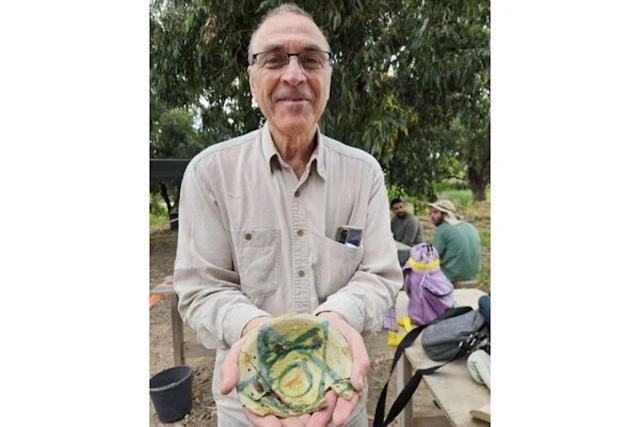In the vibrant plains near Rehovot, Israel, an exciting discovery was made at the archaeological site of Churvet Chevra. Meir El-Chasid, a local volunteer, unearthed a stunning glazed bowl adorned with intricate decorations, dating back to the Abbasid period of the 9th or 10th century. This find highlights the rich tapestry of history buried just beneath our feet and offers a vivid glimpse into the past civilizations that once flourished in the region.
The bowl's vibrant patterns are not only captivating but hold significant historical value, representing the artistic and cultural exchanges of its time. Dr. Itamar Taxel, an experienced archaeologist with the Israel Antiquities Authority and the surveyor of the site, shared insights into the symbolism found on the artifact. "In Israel, the pentagram is recognized as an artistic-magical motif common during the Islamic periods," he noted. This motif underscores the blend of aesthetics and spiritual beliefs during the period.
In the vibrant plains near Rehovot, Israel, an exciting discovery was made at the archaeological site of Churvet Chevra. Meir El-Chasid, a local volunteer, unearthed a stunning glazed bowl adorned with intricate decorations, dating back to the Abbasid period of the 9th or 10th century. This find highlights the rich tapestry of history buried just beneath our feet and offers a vivid glimpse into the past civilizations that once flourished in the region.
The bowl's vibrant patterns are not only captivating but hold significant historical value, representing the artistic and cultural exchanges of its time. Itamar Taxel, an experienced archaeologist with the Israel Antiquities Authority and the surveyor of the site, shared insights into the symbolism found on the artifact. "In Israel, the pentagram is recognized as an artistic-magical motif common during the Islamic periods," he noted. This motif underscores the blend of aesthetics and spiritual beliefs during the period.
An Israeli volunteer uncovers an ancient glazed bowl dating back to the 9th or 10th century during an archaeological dig in Israel. More at https://t.co/iNm2rVlFBk
— Israel Headline News (@IsraelHeadline) May 7, 2024
Taxel also shed light on the remarkable preservation efforts visible on the ancient bowl. It seems that previous caretakers had attempted to repair it by drilling holes to thread materials such as metal wires or lead through them, techniques that tell a story of preservation and respect for cultural heritage, which have since deteriorated.
This archaeological dig is part of a broader community initiative led by the Brenner Regional Council in collaboration with the Israel Antiquities Authority. Now in its thriving second season, the project draws volunteers from across Israel, keen to explore their heritage and learn more about their local history through hands-on experience.
The city of Rehovot itself has historical roots stretching back to its establishment in 1890 by pioneers from the First Aliyah. These pioneers were Polish Jews who aimed to create a new community, free from the influence of Baron Edmond James de Rothschild. They purchased land from a Christian Arab, facilitated by the Menuha Venahala society, a Warsaw-based organization that supported Jewish settlement in the Land of Israel. The area, initially known as Khirbat Deiran—an "abandoned or sparsely populated" estate—now lies at the heart of Rehovot's urban landscape.
This discovery not only enriches our understanding of the past but also strengthens the connection between the local community and their rich heritage. Each artifact unearthed is a testament to the historical mosaic that is Israel, offering both scholars and laypeople alike a deeper appreciation of the land's extensive, layered history.
Taxel also shed light on the remarkable preservation efforts visible on the ancient bowl. It seems that previous caretakers had attempted to repair it by drilling holes to thread materials such as metal wires or lead through them, techniques that tell a story of preservation and respect for cultural heritage, which have since deteriorated.
This archaeological dig is part of a broader community initiative led by the Brenner Regional Council in collaboration with the Israel Antiquities Authority. Now in its thriving second season, the project draws volunteers from across Israel, keen to explore their heritage and learn more about their local history through hands-on experience.
The city of Rehovot itself has historical roots stretching back to its establishment in 1890 by pioneers from the First Aliyah. These pioneers were Polish Jews who aimed to create a new community, free from the influence of Baron Edmond James de Rothschild. They purchased land from a Christian Arab, facilitated by the Menuha Venahala society, a Warsaw-based organization that supported Jewish settlement in the Land of Israel. The area, initially known as Khirbat Deiran—an "abandoned or sparsely populated" estate—now lies at the heart of Rehovot's urban landscape.
This discovery not only enriches our understanding of the past but also strengthens the connection between the local community and their rich heritage. Each artifact unearthed is a testament to the historical mosaic that is Israel, offering both scholars and laypeople alike a deeper appreciation of the land's extensive, layered history.


